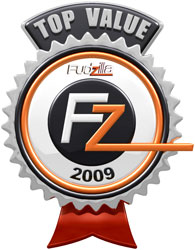

Review: GDDR4 and non-reference cooler do the job
Sapphire is well known for its non-reference cards, and today we have a chance to check out Sapphire’s HD 4670 with GDDR4 memory and non-reference dual-slot cooler. We were quite surprised by the price tag of this card as it is close to the price of the Sapphire's reference card and for few euros more you get an overclocked, non-reference cooled card with GDDR4 memory.

ATI’s HD 4670 has received a lot of attention as this mid-range card managed to beat Nvidia’s 9500GT GDDR3 card in every test. Unfortunately, even today, the HD 4670 is about €20 more expensive than the lowest priced 9500GT, but it justifies its price with its performance.
As we compared it to the 9500GT card before, today we will put it up against some more expensive cards, for example the BFG’s Overclocked 9600GT and Club3D’s non-reference dual slot HD 4670 with GDDR3 memory. Unlike some of these cards, the HD 4670 doesn’t need an additional power connector and is much shorter.
The card is based on 55nm core, and its main advantage is low power consumption and no need for additional power. It is a PCIe 2.0 card that has DirectX 10.1 support, thanks to a core that’s a crippled version of RV770 architecture (HD 4800 series). UVD 2 engine and Realtek’s HD Audio 7.1 (integrated into the GPU silicone) are responsible for quality HD reproduction and processing capabilities.
The Radeon HD 4670 is based on the RV730 core manufactured by TSMC in 55nm. It packs 320 stream processors, 8 ROPs and 32 texture units. We already mentioned that RV730 is a weaker and cheaper version of RV770 architecture, and although it’s cooler, it’s nowhere near as powerful. As far as Radeon HD 4670’s features go, you’ll find that they’re identical to those of much pricier HD 4800 generation. Even with filters on, you should still be able to play games at 1280x1024, and maybe even higher but with filters off, of course. Just like the rest of HD 4xxx series, this card supports CrossFireX multi-GPU technology.
Sapphire has decided to change the card a bit and make it even better. Unlike the reference card that comes with GDDR3 memory and single slot cooler, Sapphire has decided to go for higher clocked GDDR4 memory and dual-slot non-reference cooler. Sapphire has also used its own blue PCB, and has changed some minor layout things. The cooler takes up two slots and has a large 92mm fan.

As you can see from the picture, Sapphire has decided to cool the memory as well by placing small heatsinks. Unfortunately, two memory chips that are located underneath the GPU heatsink are not in direct contact with it so they are cooled only by the air that the fan produces.
The back side has nothing important, except for four memory chips with heatsinks.

Best of all, the card has very low energy consumption, which is evident from the lack of an external power connector. So, PCIe slot power will be enough, as the card doesn’t draw more than 75W while under full throttle.

The core of this card works at reference 750MHz, it has 320 stream processors and the mentioned 512MB of GDDR4 memory works at 1,100 MHz (2,200MHz effective). It’s important to note that HD 4670 comes with a 128-bit memory bus.
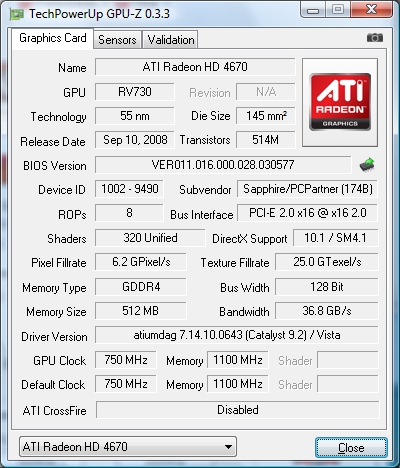
The I/O backplate is also changed as this card features D-Sub, DVI and an HDMI output.

The non-reference cooler that Sapphire has decided to use on this card was a pleasant surprise, as it is almost silent even when manually pushed to spin at 100%. In idle mode the fan spins at 34% and under load it only spins up to 47% when the card goes over 60°C, which we haven’t managed to do without overclocking, but we will get to that a bit later.


As you can see from the results the card heats up to 35°C in idle and up to 58°C under load when the fan is set to spin at auto settings. When manually pushed to spin at 100% the cards temps drop down to 33°C in idle and 50°C under load. We must note again that even at 100% the fan is less noisy than some case fans and the CPU cooler fan that we had in our system.
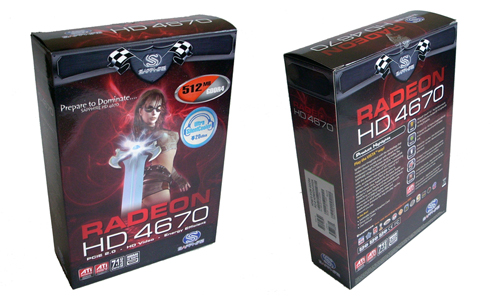
Our test sample was packed in a lite retail box, so the box is a rather small and modest, while the bundle only includes a driver CD, small Sapphire sticker and the manual.

Testbed
Motherboard: DFI DK P45 T2RS (Courtesy of DFI)
Processor: Intel Core 2 Duo E8400 @ 3.0GHz
Memory: OCZ DDR2 PC2-6400 CL 3-4-4-15 FlexXLC Edition 2x1GB (Courtesy of OCZ)
Graphics card: Sapphire HD 4670 512MB GDDR4 (Courtesy of Sapphire)
Club3D HD 4670 512MB (Courtesy of Club3D)
MSI HD 4850 T2D512 (Courtesy of MSI)
BFG 9600GT OCX ThermoIntelligence (Courtesy of BFG)
PSU: OCZ EvoStream 720W SLI (Courtesy of OCZ)
Hard drive: Seagate Barracuda 7200.9 80GB SATA (Courtesy of Seagate)
CPU Cooler: OCZ Gladiator MAX (Courtesy of OCZ)
Case fans : Gelid WING 12 UV Blue (Courtesy of Gelid)
Benchmarks
We must remind you that all of the test are done at maximum
settings. The HD 4670 will surely give much better results at lower
quality settings and since we are talking about a mainstream card, medium
settings make a lot of sense.
Futuremark Tests
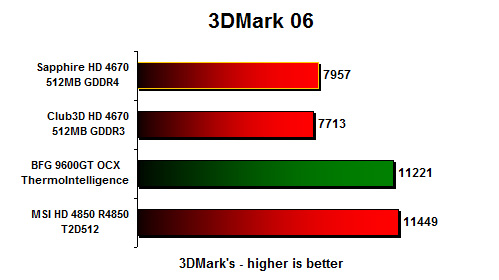
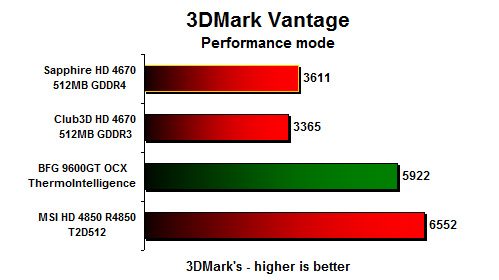
In both 3DMark 06 and 3DMark Vantage, the Sapphire HD 4670 with GDDR4 memory is clearly a bit faster than the Club3D's HD 4670 with GDDR3 memory, despite the fact that they have the same GPU clock. The higher clocked memory gives Sapphire's HD 4670 a clear win over the competition, at least in Futuremark benchmarks.
Games
The situation is similar in games, as the HD 4670 isn’t made for gaming
at high resolutions with filters. It will give you a decent frame rate
at lower resolutions, and once AA and AF are turned on, the framerate
drops significantly.
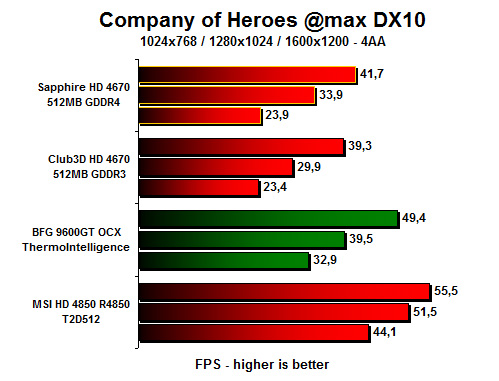
As you can see from the results, Sapphire's HD 4670 is faster than the Club3D's reference clocked HD 4670. At a higher resolution the 128-bit memory bus and the sheer lack of GPU power shows that this card just isn't made for high resolution gaming with filters and higher clocked memory can't change that fact.
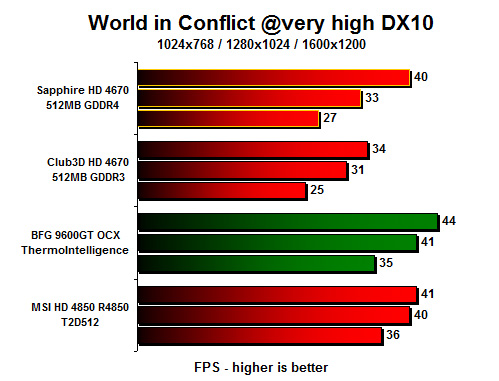
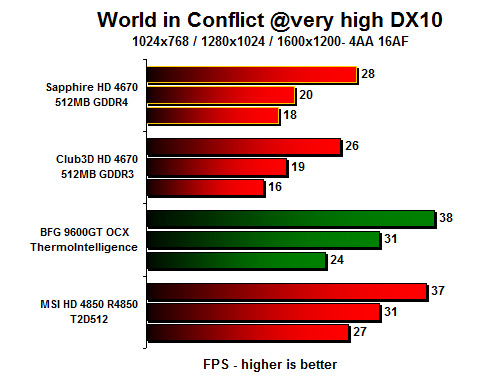
The same thing happens in World in Conflict. At lower resolutions, Sapphire's HD 4670 takes the lead over the competition but once the AA and AF comes into the game, the card simply has no muscle to cope.
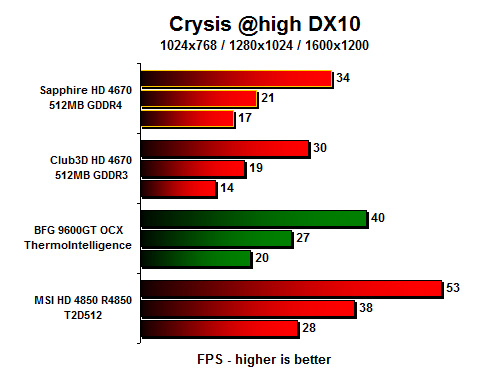
In Crysis, the card manages to even get over the magical 30FPS but only at 1024x768 and without filters. The tests were of course done at very high settings and it would be more reasonable to run it at medium settings, where this card would manage to pull some higher FPS count, even at higher resolutions.
Overclocking
Our sample managed to hit 780MHz for the GPU and 1,150MHz (2,300MHz) for the memory. The card could probably go few MHz higher but this was the most stable combination that we managed to find.
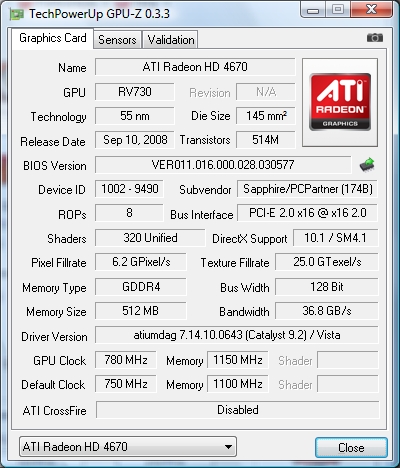
This overclock was enough to raise the score in 3DMark 06 by 285 points and 182 points in Futuremark's 3DMark Vantage. Even in Crysis we see quite a boost, but again only at lower resolutions.
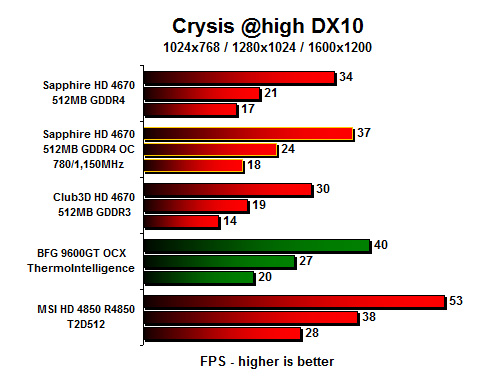
We were really surprised by the temperatures that we managed to get when the card was overclocked. We mentioned that we couldn't get the card to go over 60°C unless it was overclocked, and even then the maximum temperature that we have seen was 61°C, and that was for a short time as fan simply spins up to 47% and the temperature quickly falls below the 60°C mark.
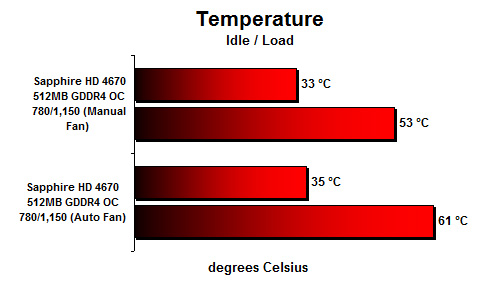
As you can see from the results we only had slightly increased temperatures when the card was overclocked which means that Sapphire did a hell of a job with this cooler.
Conclusion
Sapphire has done it again. It made a non-reference card that costs almost the same as the reference one but features higher clocked GDDR4 memory and a great non-reference cooler. The GDDR4 memory does bring a certain gain, but unfortunately, nothing spectacular. On the other hand, the cooler does a great job cooling this card, as the temperatures aren't even comparable to the reference cooled card and it is very quiet even when pushed to spin at 100%
The Sapphire HD 4670 512MB GDDR4 card is currently listed in Europe for €68,18. This is a lite retail/bulk package and the reference card in the same package costs €62,69. The same cards in full retail package are listed at €72,55 and €75,92, respectively. You can check them all out here.

The HD 4760 has a decent GPU that can cope up with Crysis, and Sapphire has made this card even better. Due to the fact that the cooler is very silent, and that it has a native HDMI output, some users might find it very suitable for HTPC systems that can take full height PCB cards. It also doesn't need an additional PCI-Express power connector, which is a great plus. The low power consumption also makes it ideal for upgrades, as you probably won't need to upgrade your PSU along with your graphics card.
The price is just right and it is a bit more expensive than the reference card, but as it has a good non-reference cooler and it comes with higher clocked GDDR4 memory we can certainly recommend it if you are shopping for an HD 4670.
